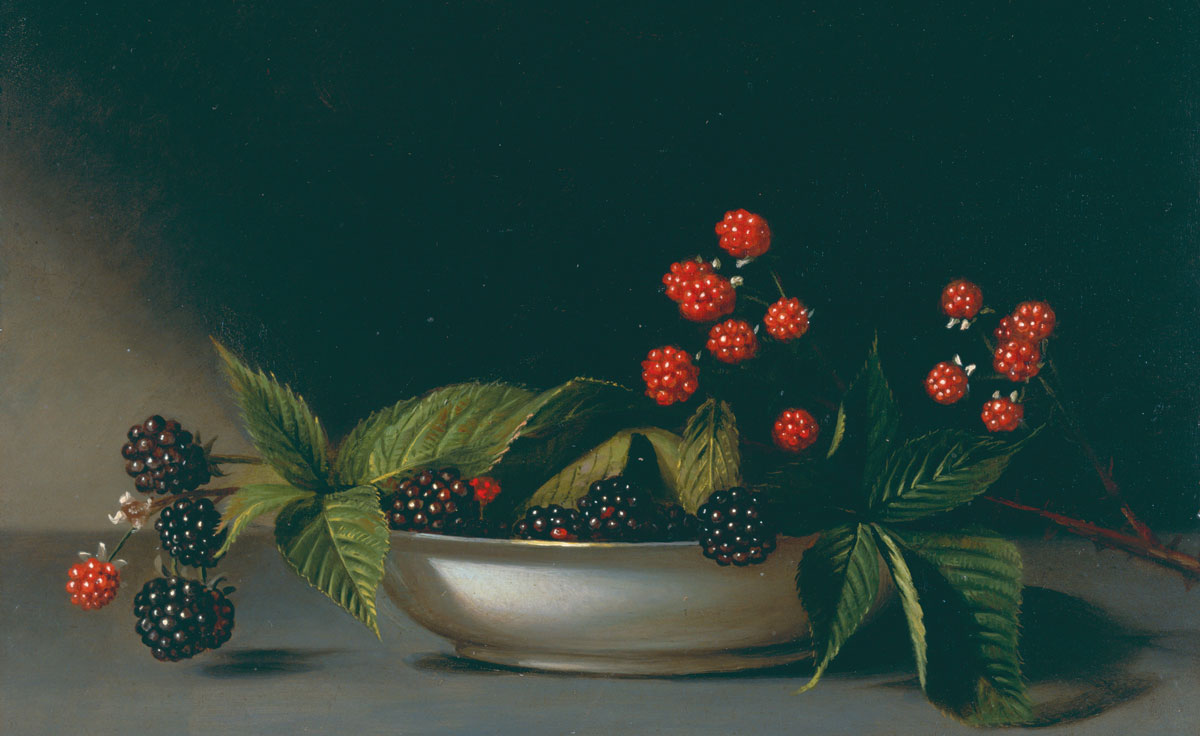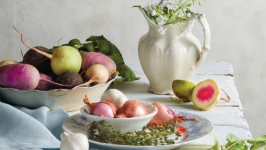Just to Say: The Early American Still Life
We on the Edible Columbus editorial board love beauty, whether it’s a candy-striped beet, a heavy table linen or a painted plate. At our last meeting of 2015, we started thinking of a way to share our enthusiasm with you and came up with the idea for “Edible Aesthetics.” Here, we’ll talk about all things beauty as it relates to food.
That decision inspired our cover design as well. This cover recalls Dutch Still Life of the 17th century. It’s the first in a series of four still-life inspired photos that we plan to style for you, one for each season of 2016.
Fresh from that editorial meeting, I left for the holidays with still-life painting on my mind. The genre has always moved me, something I attributed to the light, the rich colors and the fact that it often depicts kitchen life. Serendipity struck and I spent Christmas steps away from the Philadelphia Museum of Art and its exhibit Audubon to Warhol: The Art of American Still Life. Seeing so many still lifes in one space helped me think more about why I’m drawn to them. What I found surprised me. To look at still life isn’t to admire how light touches a bowl of fruit, but to realize how another presence, suddenly revealed, touches you.
Berry, stem, petal and seed. Meat and shell. Flesh, feather and bone. Porcelain, pewter and cloth. Raw ingredients and tableware peopled early American still-life painting with a vitality as strong as that found in the very best portraiture. More than a century after it was painted, you can almost smell the damp heat off a hare strung up by a fraying rope.
The miracle of the early American still life isn’t the thrill of a new nation’s plant and wildlife. It’s the genre’s ability to create a presence that outfoxes death. The most visceral early still lifes isolate their objects from time and place. Framed by a near-black backdrop and a simple oak table, a few farm eggs or a chunk of fresh butter might have been painted two days or two centuries ago. Removed from a specific context, quotidian objects float free from time, offering up a life force that does not diminish even though the objects themselves have long since decayed. Those eggs could be your eggs.
Still life was democratic from the start. A painter didn’t need access to a royal court or high church. A kitchen, a garden, wood and field, any and all of these places sheltered living beauty that could be plucked or foraged, shot and butchered. In America particularly, a vast expanse of natural inspiration was there for the taking. Just as hunters and farmers tamed the open landscape, early American artists, most famously John James Audubon, documented on canvas the beasts and plant life that were distinctly American.
Raphaelle Peale, the father of American still-life art, did much to catalog his young nation’s horticulture. One of his most famous works, Blackberries (c.1813), depicts the fruit at every stage of its life cycle: white flowers on stems, a few berries full and ripe, others just beginning to rot and drop their seeds. The berries’ luster and weight reflects the wealth of the new nation’s capital city and something even more divine.
Peale’s horticulture paintings were considered works of “science” because they faithfully celebrated God’s creations. Gleaming in relief against the dark backdrop, Peale’s berries float, simultaneously at all stages of life. Each careful brushstroke testifies that there, in 1813 Philadelphia, grew fruit and bramble that was more than just plant life. It was Divine presence. The trick of the still life is to make us believe that the berries are here even as we know they are gone. God, Peale’s “science” tells us, is perpetually present.
Even as still lifes grew in scale, their familiar subject matter continued to embody social values. Almost a hundred years after Peale finished his berries, Joseph Rodefer DeCamp floated a young maid against a grey background, her face turned toward window light and her arms raised as she polishes a blue china cup (The Blue Cup, 1909). More china rests on a lacquered table at her side. Only a few years earlier, during the height of the Gilded Age, china pieces would have filled the canvas. Here, at the start of the Progressive Era, material wealth is acknowledged, but there beats a more humane heart. What draws us in is the maid’s face. Softly lit, she smiles at the beautiful cup in her hand. We’ve looked that way at loveliness before. We are, in fact, looking at her that way. Our recognition of her as a kindred spirit is immediate, a cut across class lines. In her, we glimpse the thing we most want to believe about ourselves: We are not limited by our station, but carry within us an appreciation of beauty that connects us as one.
Like brush strokes, words can also evoke the magic of the still life. In This is Just To Say (1934), the poet William Carlos Williams confesses:
I have eaten
the plums
that were in
the icebox
and which
you were probably
saving
for breakfast
Forgive me
they were delicious
so sweet
and so cold
Fruit that was once there then eaten remains forever present in the reader’s mind. Like painted still life, Just To Say is and isn’t about the plums. Love is there. Passion and daring too. But it is intimacy most of all, the you and the me that value both the plums and this half-teasing closeness. In 28 words, Williams unpacks the eternal allure of the still life: a sudden intimacy that is as palpable and desirable as icy black plums on a warm, summer night.






